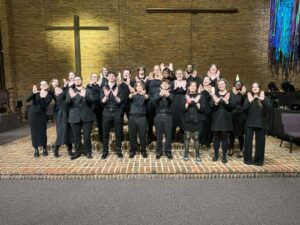Ever wonder what professors do while they’re away on sabbatical? There is less kicking back on the beach with pina coladas in hand than one might imagine.
During her sabbatical last spring, Professor of Medieval History Amy Livingstone spent her time pursuing two different projects. The first involved completing a draft of a classroom book about the lords and ladies of Beaugency, a medieval aristocratic family that lived during the Central Middle Ages (c. 1000-1300 AD). The second project emerged unexpectedly when she discovered the little-known life of Ermengard, a countess of Brittany who was an active part of many church reforms.
Livingstone traveled to France in order to uncover more about Ermengard’s life and the life of her predecessor, and she was successful in uncovering “a treasure trove of material” that she plans to use to write a biography recounting the lives of these countesses. During her time in France she also attended three conferences, wrote three articles, and reviewed three books for scholarly journals. Livingstone said, “Sabbatical allowed me to re-engage with my research and reminded me why I love history. I know I bring this enthusiasm into the classroom and can share my research and archive experiences with my students.”
Professor of History, Christian Raffensperger, has also been busy researching medieval Europe for a book that he is writing during his 2013-2014 sabbatical. He is spending the year as a Eugene and Daymel Shklar Research Fellow at the Harvard Ukrainian Research Institute, where he attends weekly seminar meetings with visitors such as the Ukrainian Ambassador to the United States and conducts research for his book project, which he explains will detail “the intersection of kinship and conflict among royal families in medieval eastern Europe.”
Raffensperger will argue in his work that historians should turn their focus to horizontal kinship structures (same-generation relatives) rather than vertical ones (family lines) in order to better understand the complex political relationships that heavily influenced the period. Such an understanding will provide “a new lens through which we can view medieval Eastern Europe, not through individual royal families, kingdoms, or countries, but as a web of interconnected individuals. Further, it will continue to show that the same, or similar, tools of analysis can be used throughout medieval Europe, furthering my overarching goal of showing that there was no East-West divide in the middle ages.”
Professor of Chemistry, Peter Hanson, who is currently on sabbatical, has been dividing his time between several different projects. In addition to finishing his non-majors chemistry textbook, he has been working with the Dayton Society of Natural History to analyze the chemical composition of soil samples from Native American archeological sites.
By studying the phosphate levels of the samples, Hanson hopes to help determine how the sites may have been used by their original inhabitants, a goal which is detailed in his sabbatical application: “Prehistoric privies have never been conclusively identified at any sites in the Midwest, but discussion with active researchers has revealed that these features may in fact be common at many Midwestern sites and are simply ignored by most archaeologists due to the general lack of artifacts.” Hanson has been doing volunteer work with the Dayton Society of Natural History as well and also plans to write papers involving chemical education research that he has conducted with students.
Professor of Philosophy, Nancy McHugh, will be splitting her sabbatical between the spring of 2014 and the spring of 2015. She has applied for an National Science Foundation grant to fund her project: “Ethical Science: A Restorative Approach to Scientific Justice.” The project’s objective, as summarized in her grant application, is “to advance and articulate a model and set of practices for addressing ethical violations in science’s and technology’s interactions with society by making stakeholders and victims an integral part of the normative process.”
McHugh explains that there is currently no framework within science for addressing ethical violations such as the mistreatment of human subjects, so restorative justice serves to “put a human face on research subjects.” She will also continue to more fully develop the restorative justice initiative with the Clark County Juvenile Court by increasing youth involvement. The restorative justice model can be used as a method of healing youth who are on probation; as McHugh stated: “We tend to commit an offense against our community because we’re broken in a certain way.”
Sabbatical provides an opportunity for professors to expand their passion beyond the classroom and into the greater world, an opportunity which Wittenberg professors are putting to good use. Whether exploring little-known facets of European history, uncovering archaeological secrets, or fighting to strengthen the ethics of scientific research, Witt’s professors are not messing around when it comes to their sabbatical time.







